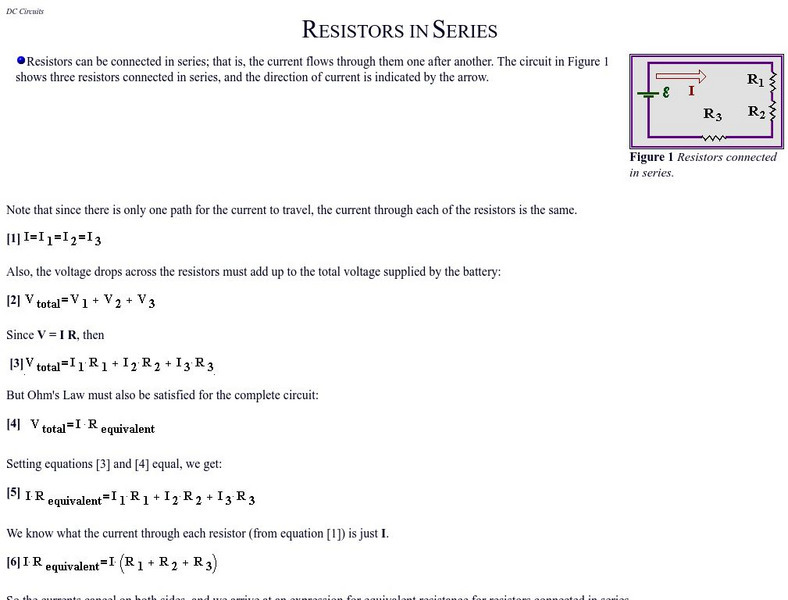Hi, what do you want to do?
Curated OER
Op-amp Oscillator Circuits
In this electrical worksheet, students draw a schematic design and build a Op-amp model to grasp the understanding of oscillator circuits before answering a series of 16 open-ended questions. Students analyze schematics in order to...
Curated OER
Active Filters
In this electrical worksheet, 1st graders design and build a circuit model to grasp the understanding of filters in circuits pertaining to impedance and cut-off frequency. They answer a series of 31 open-ended questions that include...
Curated OER
Bipolar Junction Transistor Theory
In this electrical worksheet, students draw a schematic design and build a bipolar transistor to grasp the understanding of bipolar junction transistor theory before answering a series of 28 open-ended questions. Students analyze...
Curated OER
Pulse-Width Modulation Signal Generator
In this electrical worksheet, students answer a series of 6 open-ended questions about pulse-width signal generators. This worksheet is printable and the answers are revealed online.
Curated OER
Inductive Reactance
For this electrical circuit worksheet, students draw a schematic design and build a circuit board to grasp the understanding of inductive reactance before answering a series of 13 open-ended questions. This worksheet is printable and the...
Curated OER
Impedance
For this physics worksheet, students complete 19 questions on impedance. They solve a series of mathematical and conceptual problems.
Curated OER
Impedance Matching with Transformers
In this electrical circuit worksheet, students answer a series of 19 questions by analyzing schematics dealing with the transformers. Students will determine the amount of impedance to various scenarios.
Curated OER
Design Project: Simple component curve-tracer circuit
In this circuit worksheet students complete a series of short answer questions on using a tracer circuit. There are answers with this worksheet.
Curated OER
An Introduction to Sensors
Learners list as many examples as they can of sensors in their homes and/or automobiles, define sensor and discuss what qualifies devices as sensors, explore human eyes as sensors while watching teacher demonstration, recognize that...
Curated OER
Electric Current and Circuits
Compare the drift speed of conduction electrons in a current-carrying wire to the signal speed of changes in current. They also distinguish between DC and AC and describe how AC is converted to DC.
Curated OER
Circuit Lab
Students explore the properties of electricity. This lab shows students the need for a circuit in order to have a flow of electricity. It demonstrates Ohm's law, which relates voltage, current, and resistance.
Curated OER
AC Filtering With Capacitors
Pupils investigate the properties of capacitors and discover that capacitors block DC and filter AC. They discover the function of capacitors. Students differentiate between AC and DC power. They explore the role of resistors.
Curated OER
OHM's Law
Students study the relationship between current, voltage and resistance in a series circuit. In this investigative lesson students watch a demonstration and see how voltage is measured and see what OHM's law is.
Curated OER
Construction of an Ammeter and a Voltmeter from a Galvanometer
Learners explore series and parallel circuits. For this physics lesson, students construct a simple circuit and measure its maximum current. They construct their own voltmeter and ammeter that operates at a specified range.
Curated OER
How a Circuit Works
Learners discover the basic principles of circuits by designing and testing some of their own. They are told that circuits usually have a power source such as a battery and a resistor such as a light. Students make a circuit using a...
Curated OER
Magnets
In this magnets worksheet, students describe the differences between a generator and a motor, define electromagnet, and identify a circuit as parallel or series. This worksheet has 2 short answer questions, 5 fill in the blank and 18...
Trash For Teaching
The Light-House Project
Groups work together to design a lighthouse, from designing and drawing the wiring diagram, to creating prototypes of the switch and circuit, to envisioning and building a scale model along with a blueprint. By including different...
Curated OER
Solar Kit Lesson #11 Power Maximum: An Electrical Determination
Students identify and implement methods to standardize testing stations that measure solar panel output power. After collecting electrical ouptut data from several solar panels, they plot the current-voltage and power curves. Students...
Curated OER
Electricity
Twenty-one slides cover all aspects of electricity; from electric charge, to protons, lightning, currents, the calculations for wire resistance, circuits, household devices, and fluorescence. The amount of detail and the range of...
Curated OER
Maximum Power Point
Students investigate how to optimize the power output of a photovoltaic cell using a home-made gnomon stand. They use data collected to create current-voltage and power-voltage curves to determine the "maximum PowerPoint," (MPP) at which...
Khan Academy
Khan Academy: Resistors in Series and Parallel Review
Review how to find the equivalent resistance for resistors in parallel and series configurations. Recall the current and voltage properties of series and parallel configurations of resistors.
CK-12 Foundation
Ck 12: Resistors in Series and Parallel
[Free Registration/Login may be required to access all resource tools.] The differences between series and parallel circuits are highlighted. Provides an in-depth look at how to solve problems about circuits and resistors. Includes a...
University of Guelph
University of Guelph: Physics Tutorials: Dc Circuits: Resistors in Series
Explains and illustrates the meaning of series connections. Discusses the voltage-current-resistance relationships for series connections of resistors. An example problem on series calculations can be accessed from this page.
Concord Consortium
Concord Consortium: Total Resistance for Resistors in Series
Use the tutorial to find the total resistance for resistors in a series circuit.




























